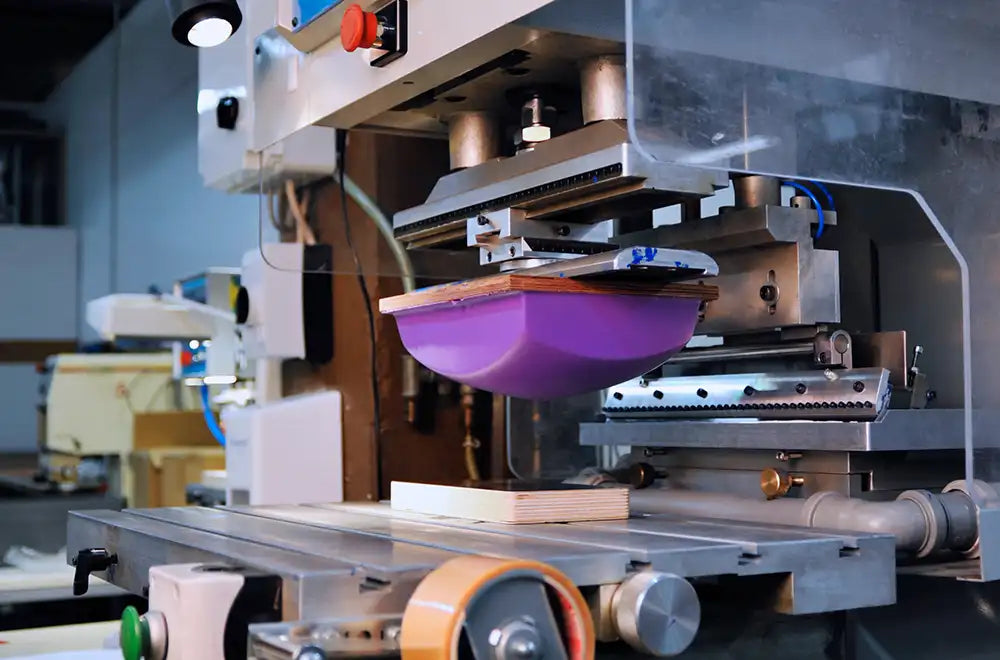Understanding Pad Printing: Applications and Advantages
•Posted on February 11 2025

Understanding Pad Printing: Applications and Advantages
Have you ever wondered how those tiny (and sometimes colorful) details get on mugs, tumblers, and even small flash drives? How about the keyboard keys on your PC or the markings on syringes? That’s the wonder of pad printing. This technique has simplified printing on the most irregular surfaces and is now more popular than ever.
So, what is pad printing, how does it work, and what are its advantages? This post will cover these details and more.
What Is Pad Printing?
Pad printing, also known as tomography, is a technique in which printers use a flexible silicone pad to transfer ink from an engraved base plate onto the material or product to be printed on (substrate). This technique is great for printing on irregular surfaces or textured materials.
How Pad Printing Works
The Pad Printing Process
Here’s a look at how the pad printing process works:
Step 1. Preparation of the Printing Plate
When you commission a pad printing project, the printer creates the image or design you want on their computer and then transfers the design to an aluminum or steel plate, using a unique engraving process. The result is a plate that can hold printing ink.
Step 2. Choosing the Right Ink
When the plate is ready, your printer will select the correct ink for the job based on the material you’re printing on, the colors in your design, and the final look you’re going for. They will mix the ink properly before use to ensure a clean final finish.
Step 3. Completing the Printing
To complete the printing, your printer will install the engraved printing plate securely onto the printing press and then apply ink to the plate.
Next, they will place the silicone pad above the plate and then press it to the plate to pick up the image. The pad will then move to the surface you’re printing on to complete the process and create your print.
Step 4. Drying and Curing
After printing, the final step is to wait for the printed object to dry. Your printer can choose to cure the ink using heat or UV light. Making sure the print dries properly is key to ensuring that it will not wear out easily.
Advantages of Pad Printing
Pad printing has become so popular today because it offers the following benefits:
Precise Printing on Irregular Surfaces
One of the most significant benefits of pad printing for industrial products is that it allows us to print on complex shapes like spheres, cylinders, and 3D objects.
Compatibility with Different Materials
Pad printing is versatile, allowing you to create prints on different materials, including plastic, glass, metal, rubber, and ceramics. This explains why many businesses in various industries use it.
High-Quality, Durable Results
The prints from pad printing aren’t just vibrant. They are also resistant to wear. Therefore, you won’t have to worry about the print fading away quickly. For a good example of the technique’s durability, look down at the letters on your computer keyboard after years of typing millions of keystrokes.
Practical for High-Volume Production
The efficiency of pad printing is why it’s the top choice for large-scale manufacturing. After you’ve created the plates, everything else can work on autopilot. This can ensure speedy production, and you don’t have to worry about any drops in quality.
Applications of Pad Printing Across Industries
Pad printing works well in various industries. Manufacturers use it in creating:
Promotional Products
It’s hard to miss pad printing applications in branding. Businesses use it to transfer company logos and other inscriptions to promotional items like mugs, pens, and keychains.
Consumer Goods
The logos on electronics, appliances, and cosmetics containers are all products of pad printing.
Industrial Components
Pad printing is important for creating industrial components. Companies use it to print calibrations and markings on medical devices, automotive parts, and more.
Sports and Recreational Equipment
Since pad printing allows the creation of high-quality designs on curved or textured surfaces, sports equipment manufacturers rely on it to create colorful custom graphics on helmets, football cleats, tennis racquets, and more.
Comparison: Pad Printing vs. Other Printing Techniques
Pad Printing vs. Screen Printing
Pad printing beats screen printing for printing on surfaces that are not flat and straightforward. Screen printing works well for printing on your regular or slightly curved objects but will likely struggle when printing on 3D objects, for example.
Also, pad printing is more cost-effective and more scalable for large-scale operations.
Pad Printing vs. Digital Printing
Digital printing is another versatile and quick approach for short runs, but it is less effective than pad printing. You can’t use it to print on as many materials, and the final print doesn’t last as long.
Innovations in Pad Printing Technology
Pad printing technology continues to develop with each passing year, making it more efficient and sustainable. Some of the improvements we’ve seen include:
-
UV-curable Ink: These inks dry quickly under UV light, lowering production time and improving print quality.
-
Eco-friendly Material Options: The evolution of eco-friendly ink, for example, minimizes the environmental impact of pad printing without hampering finish quality.
- Automated Systems: Automation has streamlined the pad printing process a great deal, making it an even cheaper option for mass production.
Why Choose Pad Printing for Your Business?
Pad printing is a fantastic option for your business if you’re looking for a quick and easy way to brand or customize your products. It’s precise and scalable and guarantees outstanding results.
However, to enjoy these benefits, you must work with the right pad printing provider for your needs. Choose a provider with extensive industry experience working with your desired materials and the right type of quality equipment.